
The Universal Declaration of Human Rights (UDHR) is an international document adopted by the United Nations General Assembly that enshrines the rights and freedoms of all human beings. Drafted by a UN committee chaired by Eleanor Roosevelt, it was accepted by the General Assembly as Resolution 217 during its third session on 10 December 1948 at the Palais de Chaillot in Paris, France. Of the 58 members of the United Nations at the time, 48 voted in favour, none against, eight abstained, and two did not vote.

Cusco, often spelled Cuzco, is a city in Southeastern Peru near the Urubamba Valley of the Andes mountain range. It is the capital of the Cusco Region and of the Cusco Province. The city is the seventh most populous in Peru; in 2017, it had a population of 428,450. Its elevation is around 3,400 m (11,200 ft).
The Virginia Declaration of Rights was drafted in 1776 to proclaim the inherent rights of men, including the right to reform or abolish "inadequate" government. It influenced a number of later documents, including the United States Declaration of Independence (1776) and the United States Bill of Rights (1789).

The Outer Space Treaty, formally the Treaty on Principles Governing the Activities of States in the Exploration and Use of Outer Space, including the Moon and Other Celestial Bodies, is a multilateral treaty that forms the basis of international space law. Negotiated and drafted under the auspices of the United Nations, it was opened for signature in the United States, the United Kingdom, and the Soviet Union on 27 January 1967, entering into force on 10 October 1967. As of February 2022, 112 countries are parties to the treaty—including all major spacefaring nations—and another 23 are signatories.
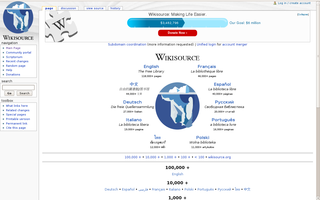
Wikisource is an online digital library of free-content textual sources on a wiki, operated by the Wikimedia Foundation. Wikisource is the name of the project as a whole and the name for each instance of that project ; multiple Wikisources make up the overall project of Wikisource. The project's aim is to host all forms of free text, in many languages, and translations. Originally conceived as an archive to store useful or important historical texts, it has expanded to become a general-content library. The project officially began on November 24, 2003 under the name Project Sourceberg, a play on the famous Project Gutenberg. The name Wikisource was adopted later that year and it received its own domain name.

Charter 77 was an informal civic initiative in the Czechoslovak Socialist Republic from 1976 to 1992, named after the document Charter 77 from January 1977. Founding members and architects were Jiří Němec, Václav Benda, Ladislav Hejdánek, Václav Havel, Jan Patočka, Zdeněk Mlynář, Jiří Hájek, Martin Palouš, Pavel Kohout, and Ladislav Lis. Spreading the text of the document was considered a political crime by the Czechoslovak government. After the 1989 Velvet Revolution, many of the members of the initiative played important roles in Czech and Slovak politics.
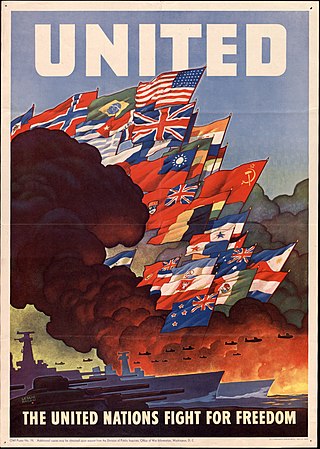
The Declaration by United Nations was the main treaty that formalized the Allies of World War II and was signed by 47 national governments between 1942 and 1945. On 1 January 1942, during the Arcadia Conference, the Allied "Big Four"—the United Kingdom, the United States, the Soviet Union, and China—signed a short document which later came to be known as the United Nations Declaration, and the next day the representatives of 22 other nations added their signatures.

The Sirte Declaration was the resolution adopted by the Organisation of African Unity on 9 September 1999, at the fourth Extraordinary Session of the OAU Assembly of African Heads of State and Government held at Sirte, Libya. The Declaration announces decisions to:

The Second Bill of Rights or Bill of Economic Rights was proposed by United States President Franklin D. Roosevelt during his State of the Union Address on Tuesday, January 11, 1944. In his address, Roosevelt suggested that the nation had come to recognise and should now implement, a second "bill of rights". Roosevelt argued that the "political rights" guaranteed by the Constitution and the Bill of Rights had "proved inadequate to assure us equality in the pursuit of happiness". His remedy was to declare an "economic bill of rights" to guarantee these specific rights:
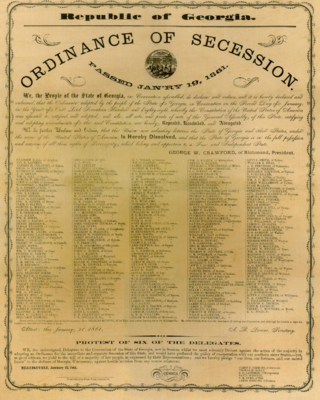
An Ordinance of Secession was the name given to multiple resolutions drafted and ratified in 1860 and 1861, at or near the beginning of the Civil War, by which each seceding Southern state or territory formally declared secession from the United States of America. South Carolina, Mississippi, Georgia, and Texas also issued separate documents purporting to justify secession.

The Constitutive Act of the African Union sets out the codified framework under which the African Union is to conduct itself. It was signed on 11 July 2000 at Lomé, Togo. It entered into force after two thirds of the 53 signatory states ratified the convention on 26 May 2001. When a state ratifies the Constitutive Act, it formally becomes a member of the AU. All 55 signatory states have ratified the document, with South Sudan and Morocco ratifying as the last African states.
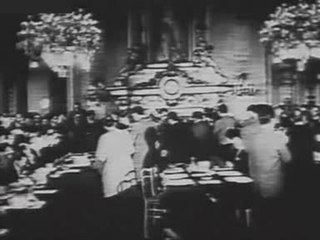
The Schuman Declaration, or Schuman Plan, was a proposal to place French and West German production of coal and steel under a single authority that later became the European Coal and Steel Community, made by the French foreign minister, Robert Schuman, on the 9th of May 1950, the day after the fifth anniversary of the end of World War II. The alliance would later be opened to other European countries. The ultimate goal was to pacify relations, especially between France and West Germany, through gradual political integration to be achieved by creating common interests. Schuman said that "[t]he coming together of the countries of Europe requires the elimination of the age-old opposition of France and Germany ... the solidarity in production thus established will make it plain that any war between France and Germany becomes not merely unthinkable, but materially impossible."

Federalist No. 23 is an essay by Alexander Hamilton, the twenty-third of The Federalist Papers. It was published on December 18, 1787 under the pseudonym Publius, the name under which all The Federalist papers were published. One of the more significant essays in the series, No. 23 attempts to justify the increased strength of the federal government under the proposed United States Constitution, compared to the then-active Articles of Confederation. The paper is entitled "The Necessity of a Government as Energetic as the One Proposed to the Preservation of the Union".

The South Carolina Declaration of Secession, formally known as the Declaration of the Immediate Causes Which Induce and Justify the Secession of South Carolina from the Federal Union, was a proclamation issued on December 24, 1860, by the government of South Carolina to explain its reasons for seceding from the United States. It followed the brief Ordinance of Secession that had been issued on December 20. The declaration is a product of a convention organized by the state's government in the month following the election of Abraham Lincoln as U.S. President, where it was drafted in a committee headed by Christopher Memminger. The declaration stated the primary reasoning behind South Carolina's declaring of secession from the U.S., which was described as "increasing hostility on the part of the non-slaveholding States to the Institution of Slavery". The Declaration states, in part, "A geographical line has been drawn across the Union, and all the States north of that line have united in the election of a man to the high office of President of the United States, whose opinions and purposes are hostile to slavery."

The Berlin Declaration is a non-binding European Union (EU) text that was signed on 25 March 2007 in Berlin (Germany), celebrating the fiftieth anniversary of the signing of the Treaty of Rome which founded the European Economic Community, the predecessor to the modern EU.
The UNASUR Constitutive Treaty, officially the Constitutive Treaty of the Union of South American Nations, was signed on May 23, 2008 during the extraordinary summit of heads of state and government of the Union of South American Nations (UNASUR) held in Brasília, Brazil. It officially established the Union of South American Nations, an intergovernmental continental union of all twelve South American nations.
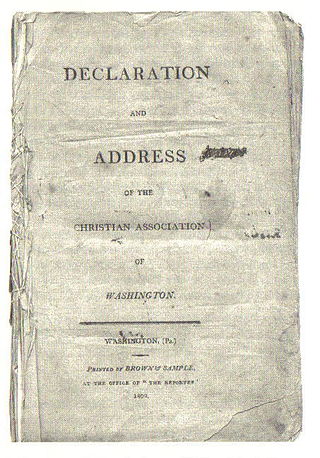
The Declaration and Address was written by Thomas Campbell in 1809. It was first published in Washington, Pennsylvania in 1809. It was the founding document for the Christian Association of Washington, a religious association that was a precursor to the Restoration Movement. In many ways, Thomas Campbell was before his time. He had an ecumenical spirit long before the ecumenical movement began. The Declaration and Address is a testimony to his appeal for Christian unity.

The Declaration of State Sovereignty of the Russian SFSR was a political act of the Russian Soviet Federative Socialist Republic, then part of the Soviet Union, which marked the beginning of constitutional reform in Russia. The Declaration was adopted by the First Congress of People's Deputies of the Russian SFSR on 12 June 1990. It proclaimed the sovereignty of the Russian SFSR and the intention to establish a democratic constitutional state within a liberalized Soviet Union. The declaration also states the following:
The Declaration on the Creation of the Union of Soviet Socialist Republics is a historical document which, together with the Treaty on the Creation of the USSR, formed the constitutional basis for the creation of the Union of Soviet Socialist Republics as a multinational state.

The Panmunjom Declaration for Peace, Prosperity and Reunification of the Korean Peninsula was adopted between the Supreme Leader of North Korea, Kim Jong-un, and the President of South Korea, Moon Jae-in, on 27 April 2018, during the 2018 inter-Korean Summit on the South Korean side of the Peace House in the Joint Security Area.















